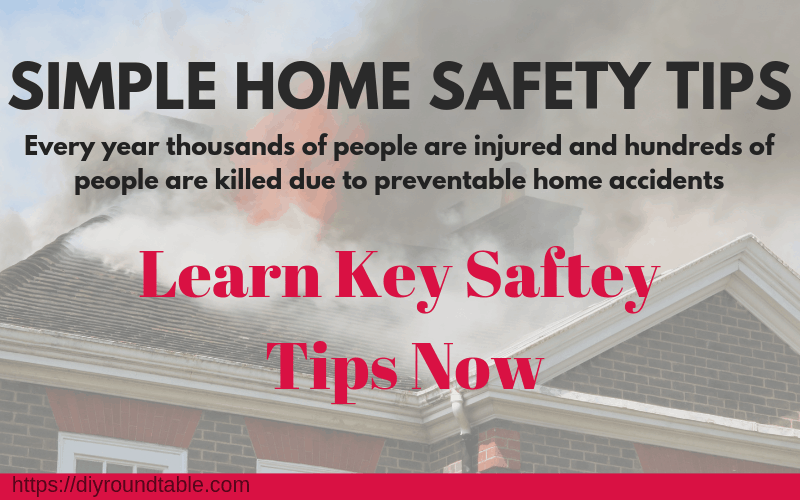This post may contain affiliate links. Please read the disclosure for more info.
Home safety is critical! Every year home fires cause over 11,000 injuries and more than 2500 deaths. People either don’t know how to use or have a plan to deal with fires in their home. They place a fire extinguisher in or around the areas they believe they could benefit from having one but seldom do they put one to use.
In my many years of dealing with home renovations, electrical, carpentry and DIY I have found myself in a few situations where I was glad to be able to know how to put out a fire with a fire extinguisher. Take a few moments to read on about how to use a fire extinguisher then read on further about some other home safety tips that will help keep you and your family safe in or around your home.
How to put out a fire with a fire extinguisher? To put out a fire using a fire extinguisher, make sure to remember the P.A.S.S. method:
- P – pull the pin to release the lock mechanism
- A – aim at the base of the fire to extinguish the fuel of the fire
- S – Squeeze the lever slowly. To stop release the lever.
- S – sweep from side to side from a safe distance to extinguish the fire.
While practice makes perfect and can give you the right confidence to deal with a home emergency remembering the P.A.S.S. method can help you stay safe. Here is more information on the P.A.S.S. method and keep reading below to get more DIY home safety tips.
Jump To:
More Tips To Put Out A Fire With A Fire Extinguisher?
• Always practice common sense when dealing with home fires. If it’s a small fire, an extinguisher can help, but if it is more than that or you don’t feel comfortable then get out, get to safety and call for help!
• All that said, having a fire extinguisher handy can avoid a small fire becoming a huge one.
• It is vital to know how to operate a fire extinguisher and test one before a fire happens!
• Check your fire extinguisher twice per year!
• Most extinguishers will shoot a chemical, dry powder or water flame retardant.
• It is critical to know which extinguishers work on which fires and which fires they will make worse!
• A water extinguisher, class A, should never be used on a grease fire! Refer to the image for more info:
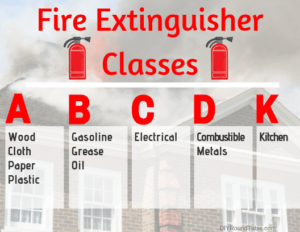
• A dry powder extinguisher will be the best purchase for a homeowner since it will extinguish almost every type of flame the homeowner will encounter.
• It’s important to note that most extinguishers have 10 seconds of extinguishing powder.
• To use a fire extinguisher, you should use the following acronym to help remember the process: P.A.S.S.
• P – pull the pin to release the lock mechanism
• A – aim at the base of the fire to extinguish the fuel of the fire
• S – Squeeze the lever slowly. To stop release the lever.
• S – sweep from side to side from a safe distance to extinguish the fire.
• Even if the fire goes out – do not walk away. Wait a few seconds to ensure it does not reignite!
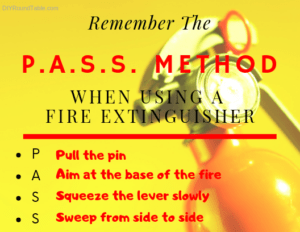
Continue reading for more info on putting out a fire and a few other home safety items that will help you around the house.
How to test and replace the batteries in smoke detectors and carbon monoxide alarms?
• A smoke detector and carbon monoxide alarm are critical to your safety.
• Most local building codes require them in residential buildings.
• A general rule of thumb is to have one on every floor.
• It is not recommended to have one in the kitchen or at least too close to the stove; the alarm could go off constantly while you are cooking.
• In a basement keep a smoke and carbon monoxide alarm near the utility room.
• Place a smoke alarm in the attic.
• Some smoke alarms and carbon monoxide detectors are hardwired, and some have batteries.
o Replacing batteries should be a priority regularly before the “chirping” starts.
o Replacing the batteries annually is a good rule of thumb.
• Many detectors and alarms come with a test button. It is a good idea to run the test. You can press the test button and listen for the responses from the alarm.
• Every five years replace the units; regardless of the guidelines from the manufacturer. I am yet to have a unit that has lasted ten years, and I do not want to take the chance. They are inexpensive and give you peace of mind!
If you are looking for a great smoke alarm and carbon monoxide battery powered solution then you have to check out Kidde. They are hands down the best in the business and I never buy anything else. I trust them and they have always outperformed other companies. I’ll link to the one I use on Amazon:
How to create and practice an emergency plan?

• A family emergency plan is vital for so many reasons. Whether it is fire, break-in, natural disaster, or other. You and your family need a plan on what to do for any situation.
• If needed, there are templates online that you can use and fill out.
Find them here: Ready.Gov
• First is to document the plan and make sure everyone knows the emergency plan. Review it and rehearse it together. Ensure it provides answers to how alerts are received, where is the shelter, what is the evacuation route, and what is the family communication strategy.
• Make sure everyone knows the plan, the details, contact info, the meeting spot if you get separated and the steps to exit the home safely.
• In case of fire make sure everyone knows where the fire extinguishers are and how to use them.
• Ensure the family members know about feeling doorknobs for heat, various escape routes, backup plans, and necessary tools are like ladders.
• Remember, no one is allowed to go back to the house for any reason!
• Ensure there is a known meeting place.
• Run a test once per year!
Why shouldn’t you leave your garage opener in your car?
• Not leaving your garage opener in your car is a critical safety protocol since many of us may leave our cars unlocked in our driveways. If you allow a thief to access your remote at home, at the valet, or car wash, you may be giving them a key to your home.
• Make sure you don’t leave your remote on your visor in a visible area overnight, or when your car is unoccupied.
• Remember the registration and insurance card gives a thief your address and easy access to your home with the remote.
• Take your remote with you or remove it from your car if you know you will be giving someone your vehicle at any point.
How to get to know your insurance policy, coverage, and deductibles?
Don’t fall into the trap of underinsuring your home to save money. While this is tempting it can lead to the significant financial burden in the long run that some homeowners can never recover from.
If you have a few hundred dollars to spend up front you can hire a professional appraiser to evaluate your home and ensure you have the right coverage and replacement costs in your policy.
Make sure you know what your current policy covers, what it doesn’t and what your deductibles are in case something happens.
For more information to help you understand your home insurance and save some money take a look at the article: 15 Ways To Save Money On Home Insurance
How to get to know your home security system?
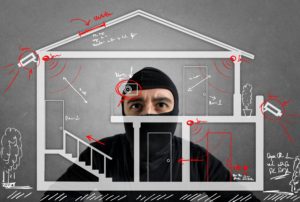
• A home security system is like a smoke detector. It is supposed to alert you of danger.
• Know your system and use your system.
• Ensure you have visible signs to help deter potential intruders.
• Consider paying for active monitoring since it can mean the difference between true safety and just faking safety.
• While many DIY home security systems exist and are great for the average user, they are allowing many intruders to get used to alarms and ignore the alarms since they are becoming numb to the noise.
• It is a great idea to have monitoring for your homes alarm system and is required to dispatch local resources regardless if it’s a false alarm or not based on the protocol that they must follow.
o Be cautious as many local areas will not be happy coming out to false alarm after false alarm and may result in fines.
• Many companies will provide a home security system for free if you sign up for a monitoring contract.
What to know about smart locks and the safety of your home?
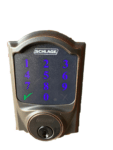
Most smart locks come in deadbolt with Bluetooth or wi-fi capabilities.
Bluetooth will require a close range (approx. 30 feet), and you are able to unlock the door before even getting out of the car.
Many smart locks come with a keypad that will allow you to enter the key code and hand out certain keycodes temporarily or to assigned users like a house cleaner, dog walker or one-time to a worker.
Most smart locks will allow you to control the lock via a smartphone.
Hacking a smart lock is possible so you want to be sure to keep your access codes safe.
Adding a smart lock can add to your home’s security and not reduce it.
For more information to help you understand smart locks, different types, buying options and some tips take a look at the article: How to install a keyless deadbolt?
What should a homeowner know about radon?
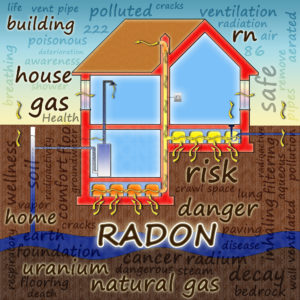
First, radon is an odorless and colorless gas that is produced from the soil and rock by decaying uranium.
Radon can enter a home through the soil then concrete into a basement and can differ from neighbor to neighbor. It can also enter a home through cracks in the foundation, walls, floors, and pipes.
Most home inspections will perform a short-term test for radon (2 – 7 days) and there are various tests any homeowner can purchase to help determine the radon levels. If you have not tested your home for radon in over two years you should do it again.
Depending on the current radon levels a homeowner may wish to have a more long-term test done that can last up to 90 days!
Most long-term tests are based on alpha particle tracks which are more accurate than other radon tests since radon levels can adjust day to day, month to month or season to season.
If you live in a home that has high radon levels (greater than 4 picocuries per liter of air or pCi/L) you may wish to take action act by contacting a professional.
Here are a few DIY solutions for reducing radon levels in your home:
- Ensure foundation walls, joints, pipes, cracks are all caulked and sealed.
- If you have a sump pump be sure there is an airtight cover over it to reduce the amount of radon that can enter to basement or crawlspace air.
- Cover the dirt in the crawlspace or basement with a vapor barrier or plastic sheet (at least 6 mil) that will run from wall to wall to help prevent radon from entering the air space.
- While some of the DIY radon solutions can help to reduce radon levels and seem simple, most situations are not a DIY job! Chances are that if you do not do the job correctly you can end up increasing the levels of radon in your home!
After work by a professional has been completed be sure to test your home again periodically.
Conclusion:
Now that you feel comfortable putting out a house fire with a fire extinguisher don’t forget to comment below on what you learned.
Comment below on some other topics you would like to see at the Round Table.
Don’t forget to like and follow us on social media!

